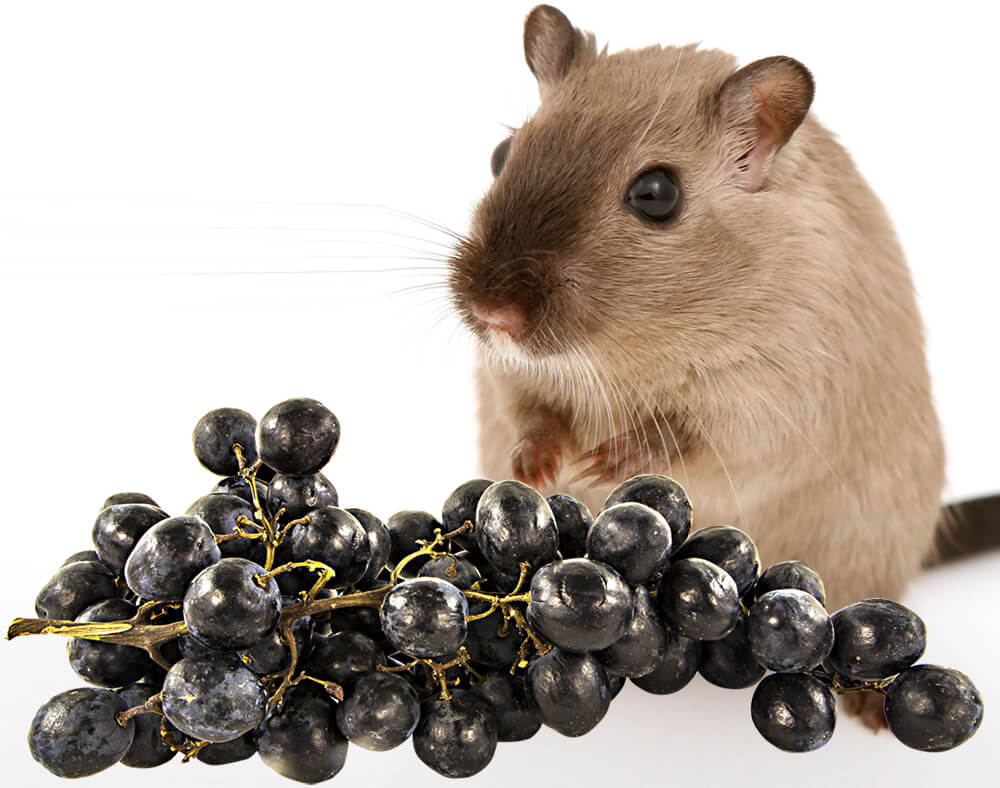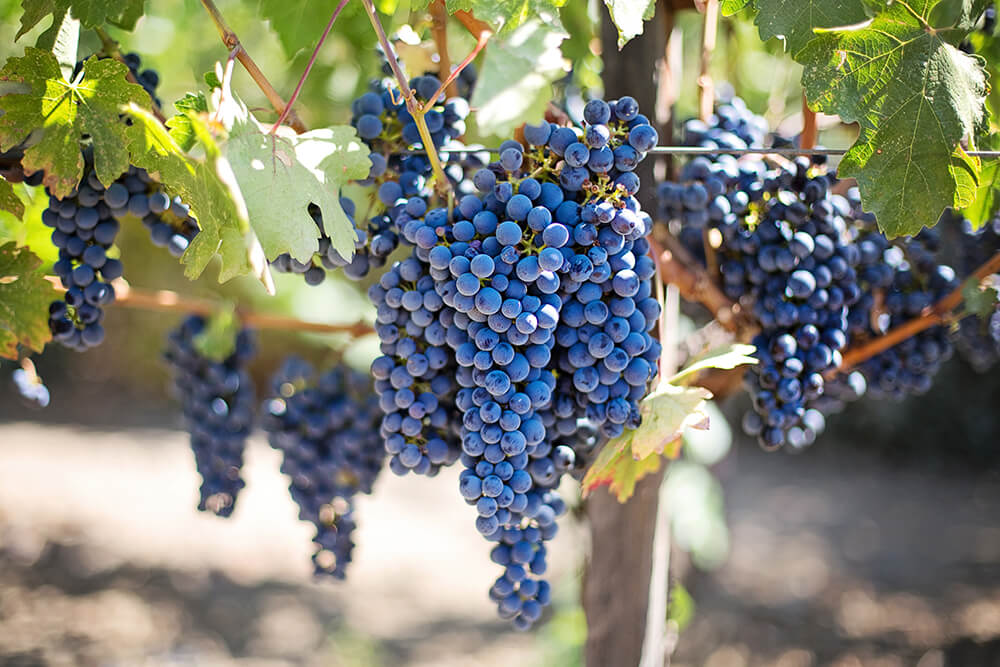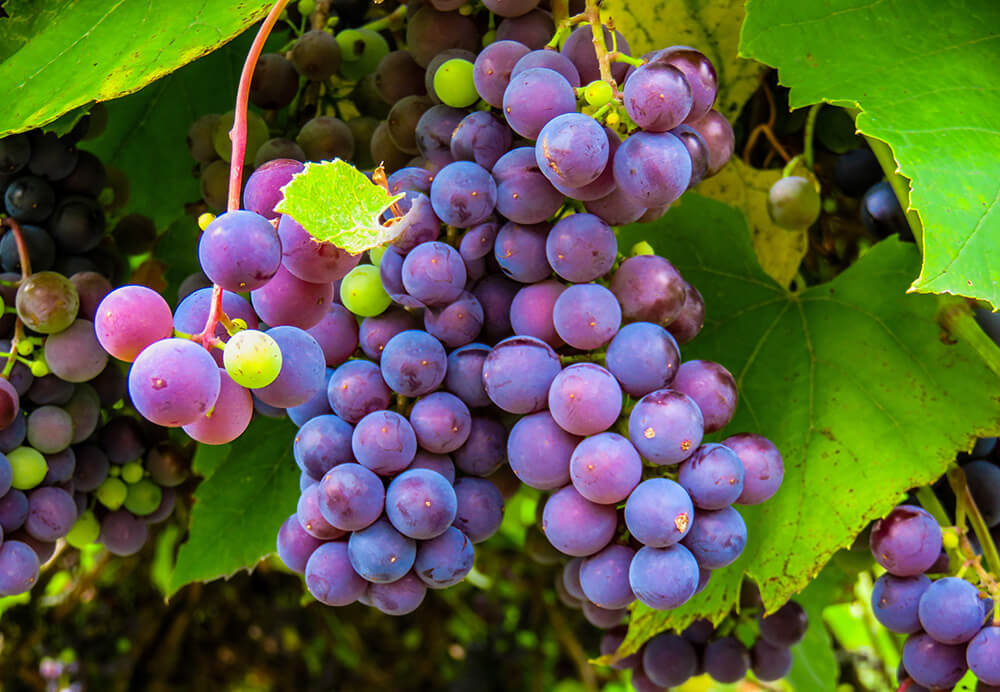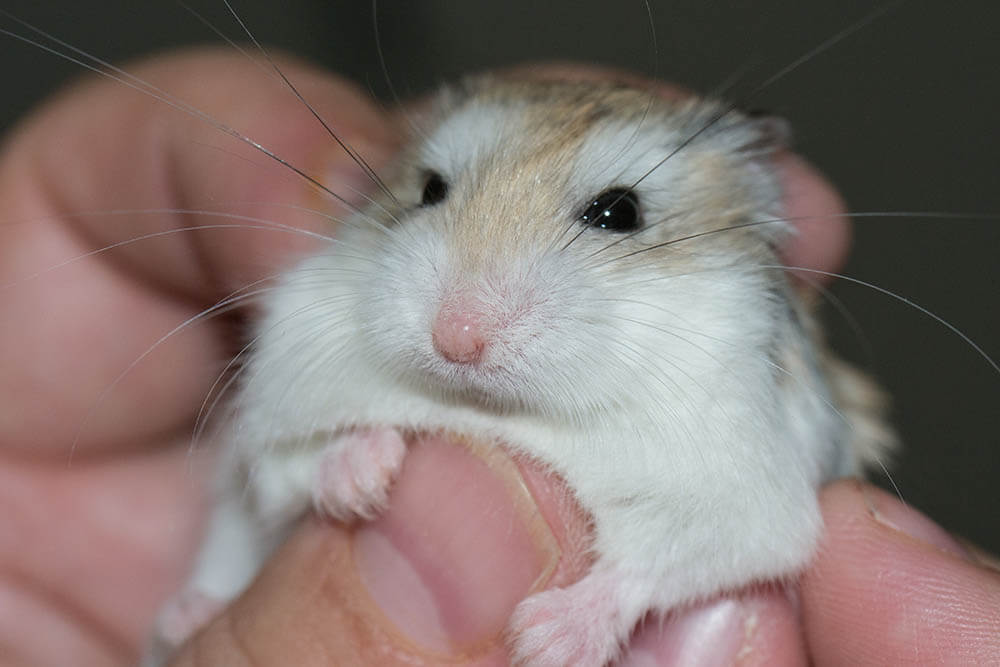Because grapes are toxic to dogs, cats, and other common pets, you may be wondering if it’s safe for hamsters to eat grapes.
Here’s the good news: yes, hamsters can eat grapes. In fact, hamsters enjoy grapes as a sweet and nutritious delicacy.
The bad news? If eaten in abundance, grapes can make your hamster ill.

So if you’re going to feed your hamsters grapes, remember that moderation is key.
Today, we’ll be discussing why such a nutrient-high fruit should only be fed to hamsters sparingly. We’ll also be answering questions such as “How many grapes can hamsters eat per week?” and “Can hamsters eat grape peel?”
The lowdown on grapes
The fleshy fruit that is the grape is a type of berry. Grapes grow on woody vines belonging to the Vitis genus of flowering plants.
Grapes have been enjoyed by humans for millennia in various ways. They can be eaten raw and fresh, processed, or as an ingredient in a dish. They’re also used to create wine and other beverages.
Grapes are highly sought-after for their delicious taste, convenient availability, and nutritional value.

Grapes: a nutrient-rich treat for hamsters
Hamsters need to consume a bevy of nutrients to stay healthy and strong. Many of these nutrients are found in grapes.
Minerals
Grapes are dense in minerals such as calcium, phosphorus, magnesium, and potassium.
Calcium and phosphorus keep your hamster’s teeth and bones healthy and strong.
Magnesium and potassium boost heart health. Potassium also helps keep the hamster’s bodily fluids balanced and aids in proper muscle function.
Vitamins
Vitamin K is found in abundance in grapes. Hamsters require this nutrient for proper blood clotting and reproductive health maintenance.
Protein
Hamsters are omnivores – they eat both meat and plants. As such, they need protein to stay healthy.
Grapes contain a good amount of protein. This nutrient enables the development of strong muscles, helps prevent various infections and illnesses, plays a key role in energy production, and allows oxygen to be efficiently transported throughout the body.
Fiber
Fresh grapes contain lots of fiber – a nutrient every hamster needs for a healthy digestive system. As your hamster gets on in years, the more fiber they’ll need in their diet.
Water
The more physically active a hamster is, the more susceptible they are to dehydration. Therefore, it’s important they’re given easy access to a regular supply of clean drinking water.
Since grapes are 80% to 84% water, they’re a good source of water for your pet.
Antioxidants
Grapes are loaded with antioxidants, which many animals, including hamsters, require to maintain the health of their heart, brain, and immune system.

Why too many grapes can be bad for hamsters
Now that we’ve discussed the health benefits hamsters enjoy when they eat grapes, let’s talk about the main reason too many grapes can be bad for your furry friend: sugar.
Like many fruits, grapes are high in sugar. And sugar, if consumed in inappropriate amounts, can make your hamster ill. Below are some of the biggest health issues your hamster can suffer from if you feed them too many grapes.
Obesity
Excess sugar intake can result in unnecessary weight gain, which can progress into obesity. An obese hamster exhibits symptoms such as lethargy and a lack of interest in exercise. If left untreated, the condition can lead to diabetes, heart disease, and a shorter life.
Diabetes
A hamster doesn’t have to be obese to be diabetic; the uncontrolled consumption of sugar alone can cause the condition. A diabetic hamster may experience increased appetite, encouraging them to eat more, which raises the risk of obesity. They may feel excessive thirst, prompting them to drink and pee more. Other symptoms include lethargy or hyperactivity, weight loss, and urine with a sugary odor.
Unmanaged diabetes can harm your hamster’s organs, ultimately resulting in death.
Fatty liver
Surplus sugar consumption can cause fatty liver disease, which is the buildup of too much fat in the liver. This unhealthy level of fat can lead to the inflammation of the liver, which, in turn, can damage the organ.
Gastrointestinal problems
A huge serving of grapes can wreak havoc on your hamster’s digestive system, causing stomach aches and diarrhea. Diarrhea can result in potentially life-threatening dehydration if allowed to go untreated.
Grape addiction
The grape’s sugary sweetness is what makes it such a delectable treat for hamsters. If they’re fed grapes in abundance, they may end up addicted to it. A grape-addicted hamster may then ignore other healthier foods in anticipation of the next high-sugar treat. This, of course, can ruin their diet and their health.

The right way to feed hamsters grapes
Because of the advantages and disadvantages of feeding your hamster grapes, grapes should be given to hamsters as an occasional treat only. They should never be a regular component of your pet’s diet.
So how many grapes should a hamster eat per week?
Remember that the average adult hamster is a tiny animal; a single grape is already a huge snack. You should therefore slice a grape up into tiny cubes, then give your hamster an amount of cubes equal to a single teaspoon.
A smaller hamster, such as a dwarf hamster, should be given a quarter to half a teaspoon of grape cubes. Wait a couple of days between feeding sessions.
In addition to slicing a single grape into tiny pieces, you should also remove the seeds and consider peeling off the skin (more on this further below).
Hamsters should only eat the appropriate amount of grapes (or any other fruit, for that matter) once or twice a week.
Never feed a baby or juvenile hamster grapes. Their sensitive digestive system won’t be able to handle all that sugar.
Introducing hamsters to grapes
The first time you give a hamster a grape, the serving size of sliced grape cubes should be smaller than appropriate – so less than a teaspoon for an average-sized adult. If your hamster doesn’t experience any problems after eating the grape, wait a few more days before giving them another grape.
Continue doing this for a week or more, each time increasing the serving size just a bit. This will get your hamster’s digestive system used to the fruit. Once it’s clear grapes aren’t causing your hamster any problems, you can give them the appropriate amount once or twice a week.
Contact a vet immediately if you do observe any problems.
Organically grown vs. non-organically grown grapes
Organically grown grapes are grapes that are grown without the help of chemicals such as herbicides, pesticides, synthetic fertilizers, etc. They are as close to natural as they come.
Non-organically grown grapes are the opposite. Before feeding such a grape to a hamster, you should thoroughly wash the skin to remove chemicals that may harm them. Alternatively, you could remove the skin and feed your hamster the grape flesh only.
In general, it’s ideal to feed your hamster fresh, organic foods.
Can hamsters eat grape seeds?
To an animal as tiny as a hamster, a grape seed is large enough to get stuck in their throat and choke them. Or it could get lodged in the digestive tract, causing a possibly deadly blockage.
For this reason, it’s better to give hamsters seedless grapes. Alternatively, you can remove the seeds as you’re slicing the grape into bits.
Natural grape varieties hamsters can eat
Grapes come in a variety of colors. Hamsters can eat all of them – though some are better for the little furballs than others.
The colors signify slight differences in the nutritional content. Green grapes usually have the most sugar of the different-colored grapes. Both purple and red grapes contain less sugar and have greater antioxidant properties, making them better for hamsters.
Dried grapes
In addition to having fewer nutrients, dried grapes, or raisins, are also loaded with even more sugar than regular grapes. While hamsters can eat raisins, they’re better off eating raw, fresh grapes.
Grape sweets
Grape pies, grape muffins, grape cakes, and other types of grape-centric delicacies are typically dense in sugar and other additives. Don’t feed them to your hamster as they can be extremely unhealthy for them.

Final thoughts
Yes, hamsters can eat grapes! More importantly, consuming this high-nutrient fruit can help boost your furry friend’s health.
As long as you never overfeed your hamster, they can continue reaping the health benefits of grapes and enjoying their sweet, delectable taste.
